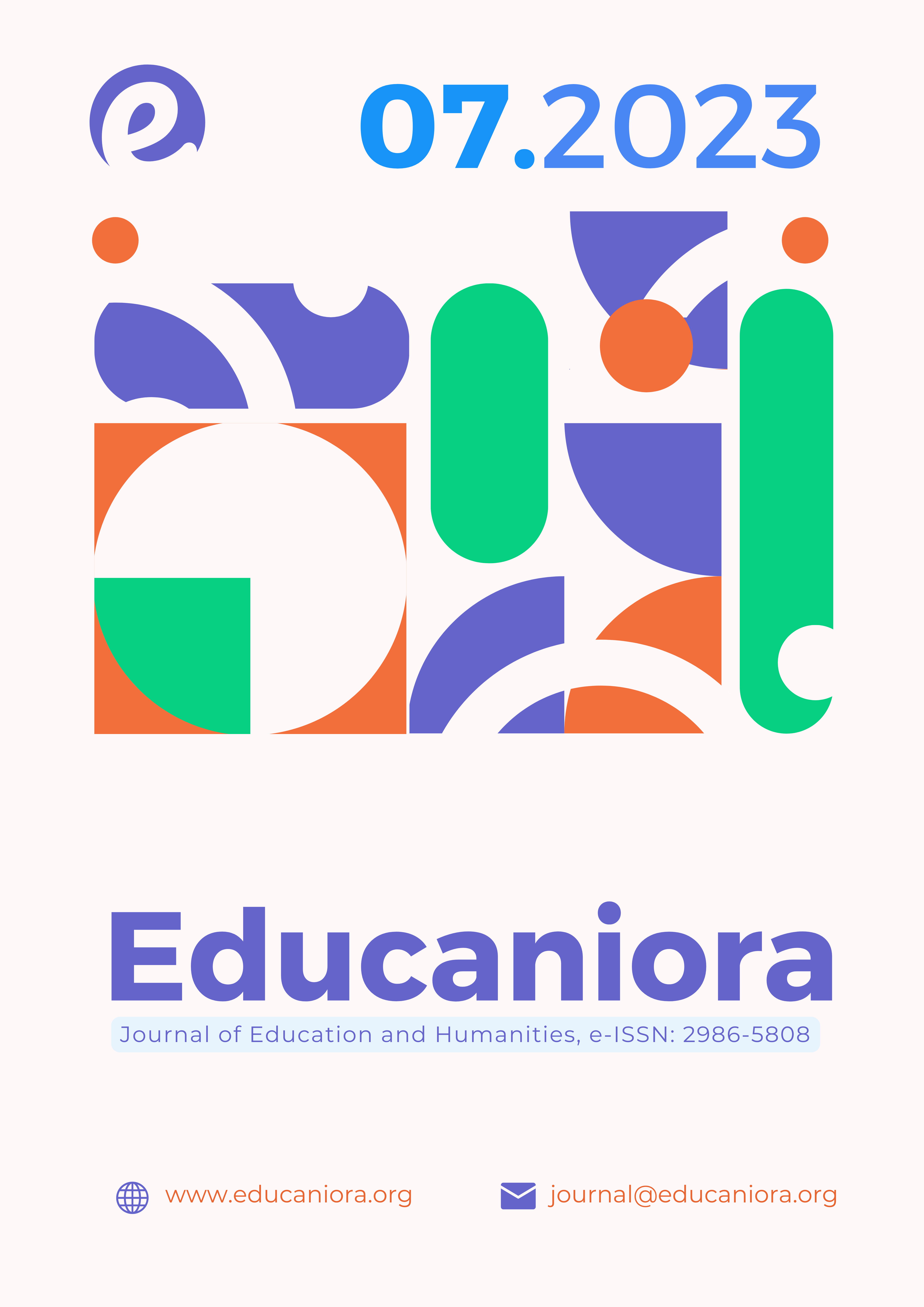Various Word Shorts in the Podcast of Political Figures Sandiaga Uno: Corpus-Based Analysis
DOI:
https://doi.org/10.59687/educaniora.v1i2.50Keywords:
abbreviation, KORTARA, political figureAbstract
This study aims to examine the use of abbreviation in the political figure Sandiaga Uno's podcast. This research will also bring up the use of corpus linguistics which is very effective in research in the field of linguistics, especially abbreviation or shortening of words. This type of research is a descriptive qualitative research. The advanced method which is the main approach of this research is the corpus linguistic method. Corpus linguistics can be interpreted as research that relies on linguistic data analysis using digital technology. The data in this study were collected using documentation techniques and utilizing the KORTARA (Korpus Nusantara) application which originates from the Wawancara Tokoh Indonesia corpus. Research data in this study will be analyzed using the KORTARA application. Analysis using the KORTARA application can be referred to as computational linguistics, because it utilizes corpus linguistics applications. The work steps of this computational linguistic analysis start from identifying data, classifying data, interpreting data, and drawing conclusions. The findings of this study reveal that the use of abbreviations in the video podcast of political figure Sandiaga Uno can be in the form of abbreviations, acronyms, and fragments. This research reveals that the most dominant type of abbreviation used in the podcast is fragment. The results of the data analysis also revealed that there were no types of abbreviations for letter symbols and contractions, this was based on the theme or discussion in the video which was not too focused on economic issues, but politics. The findings of abbreviation data in this study also reveal that the use of abbreviated or abbreviated language will continue to be used by political figures, in order to build better and more familiar communication with their interlocutors.
References
Adnan, M. S. (2019). Abreviasi Pada Berita Dalam Surat Kabar Jawa Pos. Belajar Bahasa, 4(2), 201. https://doi.org/10.32528/bb.v4i2.2560
Amran, A. F., Adam, A., & Andhira, D. A. (2022). Analisis Bahasa Gaul dalam Video Youtube Deddy Corbuzier (Kajian Sosiolinguistik : Makna Singkatan dan Makna Kiasan Bahasa Gaul). Jurnal Konsepsi, 11(1), 98–105.
Aprianto, A., Muzammil, A. R., & Syahrani, A. (2016). Abreviasi Bahasa Indonesia. Jurnal Pendidikan Dan Pembelajaran Khatulistiwa, 5(12), 1–15.
Arisanti, Y. L. (2018). Penggunaan Akronim Dan Singkatan Dalam Media Sosial Facebook Di Kalangan Remaja SMA Plus Multazam. Jurnal Literasi 2, 104–112.
Dardjowidjojo, S. (1979). Acronymic Patterns in Indonesian. South-East Asian Linguistic Studies Vol. 3, 3, 143–160. https://doi.org/10.15144/PL-C45.143
Ermanto, Havid, A., & Novia, J. (2022). Linguistik Korpus: Aplikasi Digital untuk Kajian dan Pembelajaran Humaniora. PT. Rajagrafindo Persada.
Fitriah, L., Santoso, A., & Taufiqurrahman, F. (2023). Proses Fonologis Bahasa Gaul Generasi ‘ Z ’ di Sosial Media (Analisis Fonologi Generatif). Jurnal Onoma: Pendidikan, Bahasa dan Sastra, 9(1), 80–88.
Hidayatullah, A. (2021). Analisis Abreviasi Pada Teks Editorial Surat Kabar Kompas. Caraka, 7(2), 14–28. https://doi.org/10.30738/caraka.v7i2.9887
JR, V. T. D. (2023). Partikel sebagai Pemarkah Wacana Fatis dalam Podcast @Kasisolusi. Educaniora: Journal of Education and Humanities, 1(2), 121–127. https://doi.org/10.59687/educaniora.v1i2.42
JR, V. T. D. (2023). Perbandingan Abreviasi dalam Website Blog Akmil dan Lemdiklat Polri: Metode Linguistik Korpus. Universitas Negeri Padang.
JR, V. T. D. (2023). Ujaran Kebencian Warganet pada Akun Instagram @UK (Uki Kautsar): Kajian Linguistik Forensik. Indonesia: Jurnal Pembelajaran Bahasa dan Sastra Indonesia Berada di Bawah, 4(2), 210–216.
JR, V. T. D., & Ermanto, E. (2023). Afiksasi Reduplikasi dalam Novel Hikayat Dodon Tea dan Umar Galie: Metode Linguistik Korpus. Educaniora: Journal of Education and Humanities, 1(2), 105–113. https://doi.org/10.59687/educaniora.v1i2.38
Jupriono, D., Rochim, A. I., & Hakim, L. (2023). Pelesetan Akronim sebagai Strategi Kritik Sosial dan Resistensi Verbal. TANDA:
Jurnal Kajian Budaya, Bahasa dan Sastra, 03(02), 32–48.
Kridalaksana, H. (2007). Pembentukan Kata dalam Bahasa Indonesia. PT Gramedia Pustaka Utama.
Mahsun. (2005). Metode Penelitian Bahasa. PT Rajagrafindo Persada.
McEnery, T., & Hardie, A. (2011). Corpus Linguistics. Cambridge University Press.
McEnery, T., & Wilson, A. (2001). Corpus Linguistics (p. 235). Edinburgh University Press.
Moehnilabib, M. dkk. (2003). Dasar-Dasar Metodologi Penelitian. Universitas Negeri Malang.
Mufrida, F., & Zultiyanti. (2023). Proses pembentukan akronim dan singkatan pada berita harian Detik.com. Aksara: Jurnal Ilmiah Pendidikan Bahasa dan Sastra Indonesia, 7(1), 67–75.
O’Keeffe, A., & McCarthy, M. (2010). The Routledge Handbook of Corpus Linguistics. Taylor & Francis e-Library.
Pramesti, D. A., & Putri, R. K. (2023). Penggunaan Singkatan dan Akronim dalam Media Chat di SMK Swasta. Jurnal Ilmiah Pendidikan Kebudayaan dan Agama, 1(1), 06–16.
Prasticha, N. D., Sinaga, M., & Septyanti, E. (2023). Fenomena Abreviasi Pada Media Sosial. Jurnal Pendidikan dan Konseling, 5(2), 1535–1543.
Tarigan, H. G. (1984). Pengajaran Kosakata. Angkasa.
Waridah, E. (2008). EYD & Seputar Kebahasa-Indonesiaan. Kawan Pustaka.
Zaim, M. (2015). Pergeseran Sistem Pembentukan Kata Bahasa Indonesia: Kajian Akronim, Bleding, dan Kliping. Linguistik Indonesia, 33(2), 173–192.
Downloads
Published
How to Cite
Issue
Section
License
Copyright (c) 2023 Vicno Triwira Dhika JR, Teuku Thifly Fakhrur Rizal

This work is licensed under a Creative Commons Attribution-NonCommercial 4.0 International License.
The use of the article will be governed by the Creative Commons Attribution-NonCommercial 4.0 International License (CC BY-NC 4.0). This license permits anyone to copy and redistribute this material in any form or format, compose, modify, and make derivatives of this material for non-commercial purposes, as long as they give appropriate credit to the original author(s) and Educaniora.






















